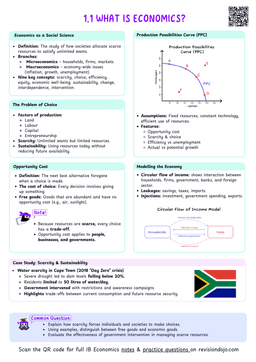Just as the SRAS curve can shift in the short-run, both the LRAS curve and the Keynesian AS curve can shift in the long-run.
Shifts in the long-run aggregate supply occur when there is growth in the production possibilities of the economy:
- If there is an increase in the production possibilities, the economy has grown its factors of production and so can produce more real output in the long-run (when there is full employment of resources).
- Therefore, in the long-run, there is an increase in the real output an economy produces at all possible price levels.
- This shifts the LRAS curve and the Keynesian AS curve.
Shifts in the LRAS curve
- When there is an increase in the production possibilities of an economy, the LRAS curve shifts to the right (LRAS1→LRAS2) to a new potential output (Yp1→Yp2).
- When there is a decrease in the production possibilities of an economy, the LRAS curve shifts to the left (LRAS1→LRAS3) to a new potential output (Yp1→Yp3).

Shifts in the Keynesian AS curve
- When there is an increase in the production possibilities of an economy, the Keynesian AS curve shifts to the right (AS1→AS2) to a new potential output (Yp1→Yp2).
- When there is a decrease in the production possibilities of an economy, the Keynesian AS curve shifts to the left (LRAS1→LRAS3) to a new potential output (AS1→AS3).

Determinants of aggregate supply over the long-run
- While changes in the PL cause movements along the LRAS curve / Keynesian AS curve, changes in the production possibilities of the economy shift the curves.
- The factors that change the production possibilities of an economy can hence be understood as the determinants of aggregate supply over the long-run.
The determinants of aggregate supply over the long-run covered in the IB curriculum are:
- Changes in the quantity and/or quality of factors of production.
- Improvements in technology.
- Increases in efficiency.
- Changes in institutions.
In IB Economics long-answer questions, it is very important to explain processes step-by-step, without skipping any steps.
In this section, the effect of changes in the determinants of SRAS will be explained in such way.
Changes in the quantity and/or quality of factors of production
Increase in the quantity and/or quality of factors of production → rightward shift in LRAS / AS
- Factors of production refer to the resources used in the production process: land, labor, capital, and entrepreneurship.
- If the quantity of factors of production increases (larger labor force, discovery of new resources, or increased capital stock...), the economy's production possibilities increases.
- Similarly, improvements in the quality of factors of production (higher-skilled workers, better technology, or more efficient capital...) also increases the economy's productivity.
- Since long-run aggregate supply represents the economy's potential output at full employment, an increase in the quantity and/or quality of resources increases the economy's potential output through a growth in production possibilities.
- This shifts the LRAS curve / AS curve to the right (LRAS1→LRAS2 / AS1→AS2).

Decrease in the quantity and/or quality of factors of production → leftward shift in LRAS / AS
- Factors of production refer to the resources used in the production process: land, labor, capital, and entrepreneurship.
- If the quantity of factors of production decreases (shrinking labor force due to aging population or emigration, depletion of natural resources, or reduced capital stock...), the economy's production possibilities decreases.
- Similarly, declines in the quality of factors of production (poorly educated workforce, outdated technology, or inefficient capital...) also decreases the economy's productivity.
- Since long-run aggregate supply represents the economy's potential output at full employment, a decrease in the quantity and/or quality of resources decreases the economy's potential output through a decrease in production possibilities.
- This shifts the LRAS curve / AS curve to the left (LRAS1→LRAS2 / AS1→AS2).


